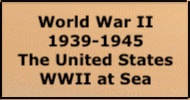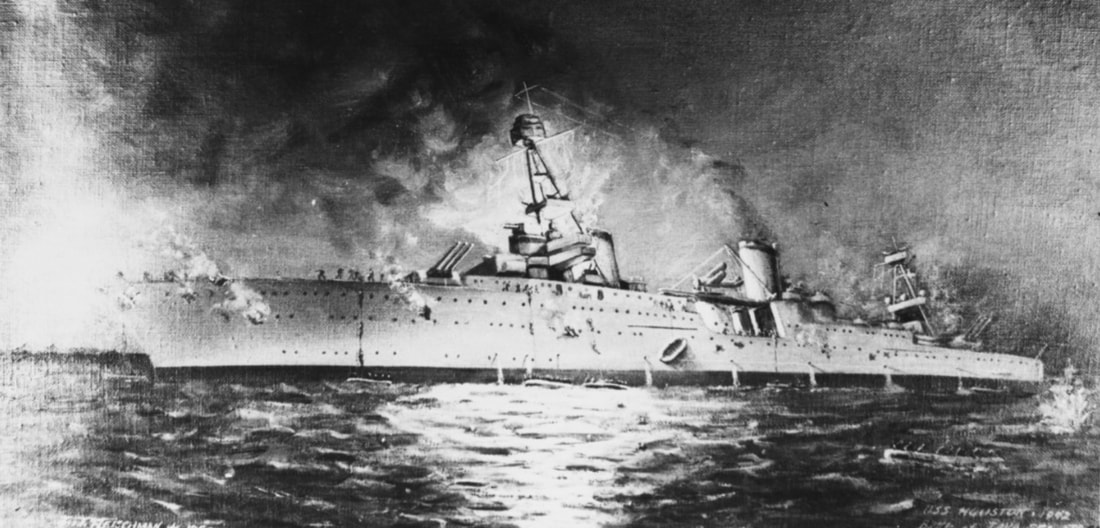|
|
bigpigeon.us webpage WWII US > WWII at Sea, © 2023 by Robert A. Christiansen, links checked by RAC 15 Aug 2022, updated by RAC 13 Dec 2023.
My major links for WWII at Sea
My Big Pigeon webpage listing Pottawattamie Area WWII Dead Roster member shipboard deaths:
- WWII Dead > The Land, Air, Sea Dead > The Sea Dead - updated 30 Sep 2023
- US Maritime Losses in the War with Japan - 33 pp., updated 3 Aug 2023
- US Maritime Losses in the War with Germany - 23 pp., updated 3 Aug 2023
The United States Navy in World War II - a Brief Summary
When the United States entered WWII in December 1941, the United States Navy was the second strongest navy in the world, preceded by Great Britain (the Royal Navy) and followed by the Japanese Empire (the Imperial Japanese Navy - IJN). The German navy (the Kriegsmarine) was much smaller.
WWII at sea was fought in three dimensions: on the surface, by submarine, and from the air using land bases and aircraft carriers.
In the War with Germany, the Allied navies focused on protecting Allied merchant shipping and supporting the Allied amphibious invasions in North Africa, Sicily, Italy and France. Thus, the United States made little use of submarines in the Atlantic area.
Unlike Germany, the Japanese Empire relied heavily on merchant shipping. US submarines in the Pacific were the largest factor in the destruction of the Japanese merchant fleet. Carrier-based naval aviation supported amphibious operations as US Army and Marine Corps ground forces moved in a generally northwesterly direction from island to island towards the Japanese home islands. Surface ships provided antiaircraft protection for the carriers and shore bombardment during invasions, and on a few occasions engaged Japanese surface ships in pitched battles.
WWII at sea was fought in three dimensions: on the surface, by submarine, and from the air using land bases and aircraft carriers.
In the War with Germany, the Allied navies focused on protecting Allied merchant shipping and supporting the Allied amphibious invasions in North Africa, Sicily, Italy and France. Thus, the United States made little use of submarines in the Atlantic area.
Unlike Germany, the Japanese Empire relied heavily on merchant shipping. US submarines in the Pacific were the largest factor in the destruction of the Japanese merchant fleet. Carrier-based naval aviation supported amphibious operations as US Army and Marine Corps ground forces moved in a generally northwesterly direction from island to island towards the Japanese home islands. Surface ships provided antiaircraft protection for the carriers and shore bombardment during invasions, and on a few occasions engaged Japanese surface ships in pitched battles.
Hull Numbers:
US Navy ships possessed both a name and a two-part hull number, with the first part of the hull number identifying the type of ship and the second a serial number. Some examples of hull numbers using members of the Pottawattamie Area WWII Dead Roster:
Ship Name Prefixes:
US Navy ships possessed both a name and a two-part hull number, with the first part of the hull number identifying the type of ship and the second a serial number. Some examples of hull numbers using members of the Pottawattamie Area WWII Dead Roster:
- The heavy cruiser USS Minneapolis, on which Rex Knapp was entombed, had the hull number CA-36.
- The light cruiser USS Juneau, on which Walter Lueth and the five Sullivan brothers from Iowa died, had hull number CL-52.
- Two roster members, Lester Christensen and Bernard Kaiser, were among the 793 dead in the loss of the heavy cruiser USS Houston (CA-30) in early 1942. Roster member Claude Cody died on a second USS Houston (CL-81), which was nearly lost after the carrier raids on Formosa in October 1944.
- The escort carrier USS Nehenta Bay, near which Harlan Fisher died while attempting to land, had hull number CVE-74.
- The submarine USS Pompano, which disappeared while on patrol carrying William G. Messerschmidt Jr., had hull number SS-181.
- Landing ship, tanks, sometimes called tank landing ships, did not have names during WWII. Roster member Walter P. H. Thompsen was a passenger on the British LST-422, on which hundreds died.
Ship Name Prefixes:
- United States Navy ships - USS
- steam-powered US commercial ships - SS for steamship
- diesel-powered US commercial ships - M/S for motor ship
Sources for Big Pigeon's WWII US > WWII at Sea webpage:
Major worldwide WWII maritime losses:
Major worldwide WWII maritime losses:
- https://en.wikipedia.org/wiki/Lists_of_shipwrecks - organized by date, scroll down to 1939 to 1945
- https://en.wikipedia.org/wiki/List_of_maritime_disasters_in_World_War_II - major losses sorted by death toll
- https://ia600306.us.archive.org/21/items/TheOfficialChronologyOfTheUSNavyInWorldWarII/TheOfficialChronologyOfTheUSNavyInWorldWarII.pdf
- https://www.history.navy.mil/research/histories/ship-histories/danfs.html - Dictionary of American Navy Fighting Ships
- https://www.history.navy.mil/research/histories/ship-histories.html - US Navy ship histories
- 1941-42 - https://www.naval-history.net/WW2UScasaaDB-USNBPbyDate1941-42.htm
- 1943 - https://www.naval-history.net/WW2UScasaaDB-USNBPbyDate1943.htm
- 1944 - https://www.naval-history.net/WW2UScasaaDB-USNBPbyDate1944.htm
- 1945 - https://www.naval-history.net/WW2UScasaaDB-USNBPbyDate1945.htm
- https://en.wikipedia.org/wiki/List_of_US_Navy_ships_sunk_or_damaged_in_action_during_World_War_II
- https://en.wikipedia.org/wiki/List_of_United_States_Navy_losses_in_World_War_II
- https://en.wikipedia.org/wiki/Okinawa_naval_order_of_battle - extensive information on the Battle of Okinawa
- http://www.navweaps.com/index_tech/tech-042.php - Kamikaze Damage on US and British Carriers
- http://www.uscarriers.net - click on decommissioned to see a list of WWII aircraft carriers
- http://www.ibiblio.org/hyperwar/USN/SubLosses/SS_losses-Intro.html#chron
- http://www.ibiblio.org/hyperwar/USN/SubLosses/index.html#index
- https://www.oneternalpatrol.com/wwii.htm
- https://www.oneternalpatrol.com/wwii-submarine-losses.html
- https://www.oneternalpatrol.com/submarine-losses.htm
- http://www.usmm.org/natlantic.html#anchor531799 - organized by area, chronologically, & alphabetically
- https://www.armed-guard.com/sunk.html
- The webpage header image, Sinking of the USS Houston, is taken from https://www.history.navy.mil/content/history/nhhc/our-collections/photography/numerical-list-of-images/nhhc-series/nh-series/NH-93000/NH-93153.html - c/o Naval History and Heritage Command, catalog # 93153, 1950 painting by Joe T. Fleischman. This painting depicts the fate of the USS Houston (CA-30) in the Battle of Sunda Strait between Java and Sumatra on 1 March 1942.


